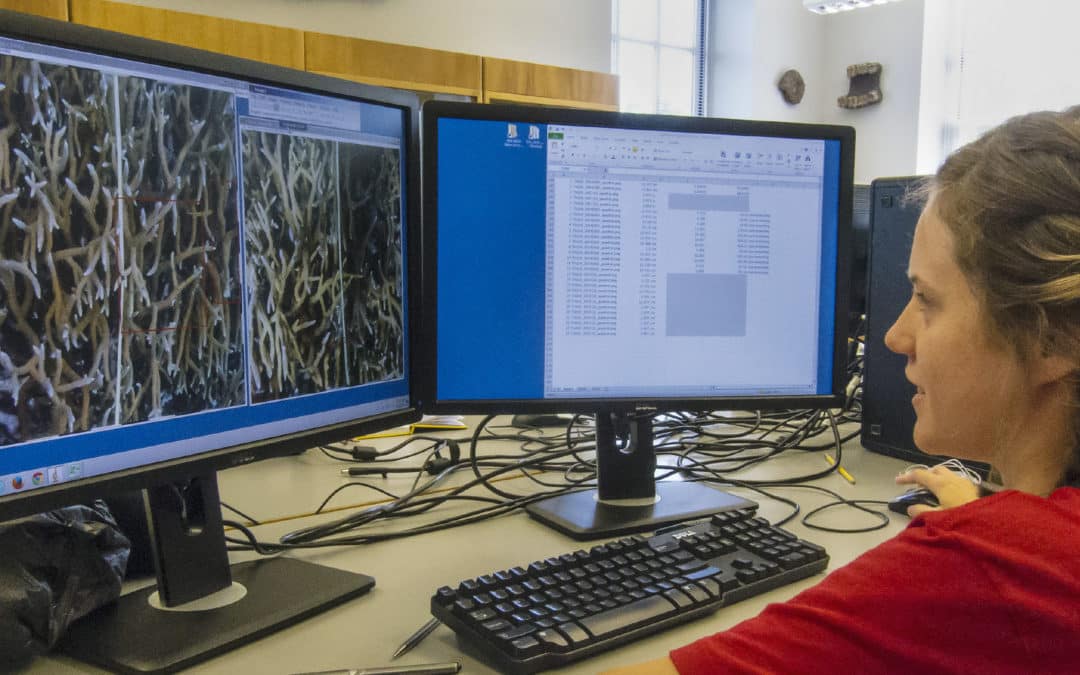Resilience and decline: Are we at a tipping point for endangered Acropora sp. corals in Belize?
Overview: Acropora cervicornis (Staghorn coral) and Acropora palmata (Elkhorn Coral) have been important coral reef builders throughout the recent geologic past. Yet thriving acroporid populations are now exceptionally rare in the Caribbean. Causes cited for the dramatic decline of this (and other coral) species vary, but are virtually all tied directly or indirectly to human-induced environmental or climatic change. In the most recent years we have seen an explosion of research documenting the rapid decline of corals worldwide, and dire predictions of looming collapse. But hope remains that there may be some coral refugia to withstand collapse long enough for local, regional, or global intervention and/or stabilization to occur. Coral Gardens, Belize is one candidate for persistence of endangered Acropora sp. corals, but for how long, we do not know. It is critical to understand working systems if we hope to promote persistence in coral communities, recruits for transplantation, best practices in management, and an understanding of human/environment interactions moving into a climate-stressed future. This project is aimed at assessing the current status of living acroporid-dominated coral reefs off Ambergris Caye, Belize, and expanding the range of previous work in this area.
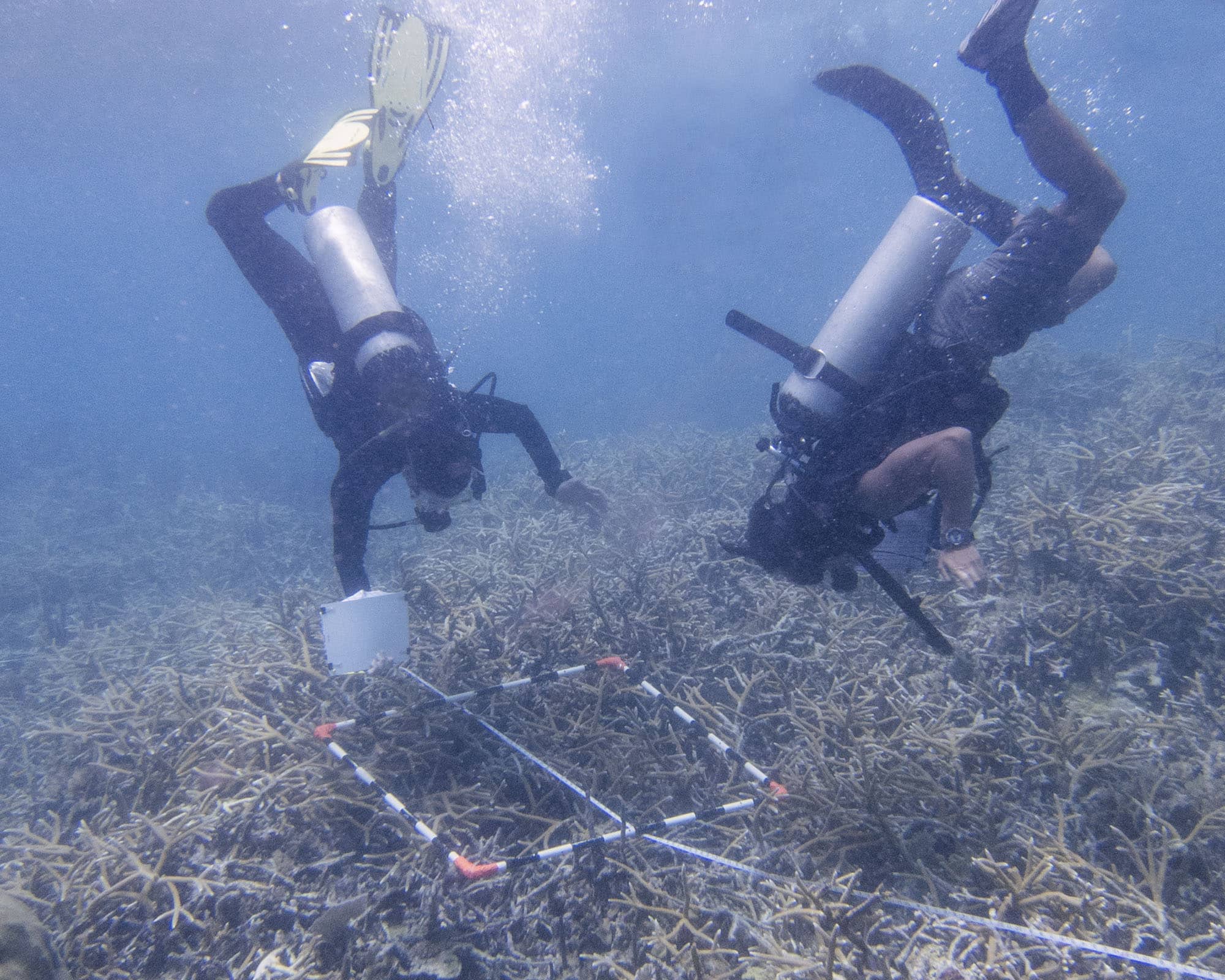
Keck Geology students studying corals along a transect.
When: June 14-July 18, 2019 (tentative)
Where: Laboratory work at Washington and Lee University (Lexington, Virginia) and field studies in Ambergris Caye, Belize.
Who: Eight students, a peer mentor (Ginny Johnson, W&L ’20), and project directors Dr. Lisa Greer (Washington and Lee University, greerl@wlu.edu) and Dr. Karl Wirth (wirth@macalester.edu)
Prerequisites and Recommended Courses: Because this experience is a Gateway Project, there are no specific coursework prerequisites. We are seeking students who are interested in many or all of the following: coral reefs, the fossil record, ecosystem dynamics, geochemistry, human impacts to the environment, natural and manmade climate change, and using field and laboratory methods to explore scientific questions about Earth systems.
All students are required to be capable swimmers. This does not mean that students need be expert swimmers, but that they can be safe in the water for prolonged periods (see below). Soon after acceptance to the project students will be required to submit a completed PADI scuba medical questionnaire (and signed by a doctor for certain pre-existing conditions). Prior to arriving at Washington and Lee for the start of the project participants will submit a signed (by swim coach or athletics staff at their home institution) form certifying that the student can complete the minimum swim skills required for SCUBA certification (swim 200 yards and float/tread water for 10 minutes). These skills will be tested again at the beginning of the confined water scuba training. Students should indicate their comfort in water in their application materials. Students should be willing to live in close quarters, be in the heat and sun for much of the day, be on a boat for much of the day, and work well with others.
Expectations and Obligations:
1. Participation in all project-related work during the summer (5 weeks)
2. Submission of an abstract (individual or in groups) and presentation of a paper (poster or talk) at the Geological Society of America National Meeting in Phoenix, AZ or the American Geophysical Union meeting in San Francisco in Fall 2019 (all expenses covered).
PROJECT DESCRIPTION
The goals of this project are to determine 1) whether acroporid reefs at Coral Gardens, Belize are in recovery or continued decline after Hurricane Earl and whether heat-induced stress dramatically impacted living coral in 2016, 2) the degree to which recent decline has theoretically impacted reef accretion rates at this site, 3) how well our previous remote satellite-based mapping of living coral serves as an accurate predictor of coral abundance, 4) the temporal persistence of corals at this site using radiocarbon and uranium series dating of critical time periods, 5) past environmental conditions using geochemical proxy data, and 6) whether temperature and light data show significant change over the period of study (2011-present) and whether there is environmental heterogeneity across several reef sites. In addition, we will expand the study beyond the area we have been working in since 2011. This project will use photographic, in situ, satellite, and laboratory measurements of coral and algal growth, herbivore density, environmental conditions, and coral chemistry to characterize reef ecosystem dynamics in time and space.
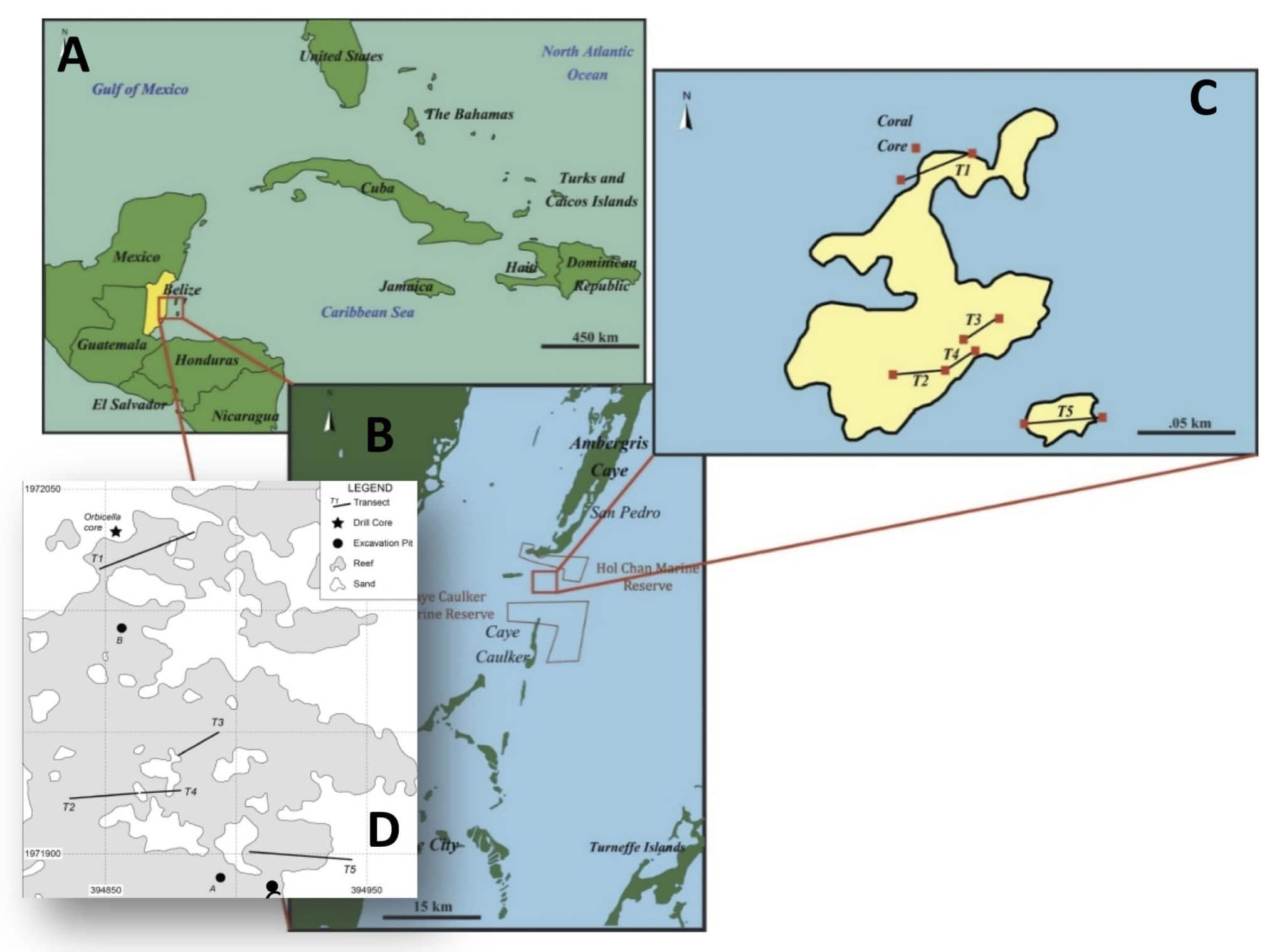
Figure 1: Map of Coral Gardens on the Mesoamerican Barrier Reef off the coast of Belize. Map A shows the relative location in the Caribbean and map B shows the location of Coral Gardens and marine reserves near the study site. Red squares at Coral Gardens (C) mark buoys and straight black lines mark coral transects within the study area. D is a detailed map of live coral produced by 2014-15 Keck students.
Background
Acroporid reefs in decline: Acroporid coral species are currently experiencing massive die-offs throughout the Atlantic basin and A. cervicornis and A. palmata are listed as threatened on the U.S. Department of the Interior Endangered and Threatened Wildlife list. Many scientists fear that A cervicornis may be particularly sensitive to environmental change and the demise of the species may be a sign of impending doom for Caribbean reefs in general (e.g. Precht and Aronson, 2004). A primary cause for collapse is White Band Disease (Rogers, 1985; Aronson and Precht, 2001), but many anthropogenic factors may be enhancing or driving disease effectiveness. Of the human-influenced threats to corals, macroalgae abundance due to overfishing and eutrophication, climate change, and potentially ocean acidification seem most important. In the last few decades reefs have experienced dramatic shifts from coral- to algae-dominated ecosystems (Hughes, 1994; Pandolfi et al., 2005), and it is now abundantly suggested that climate change may induce a massive collapse in coral reefs worldwide (e.g. Hughes et al., 2017; 2018).
Most living A. cervicornis today exist in small patches and isolated colonies, and true A. cervicornis-dominated ‘reefs’ are now rare (Miller et al., 2009). The question of whether the recent die-off of acroporids is anomalous with respect to the geologic record has been a subject of debate. Several key studies on the persistence of A. cervicornis prior to the 1980’s have been from Belize (Aronson et al., 1998; Aronson et al., 2002; Wapnick et al., 2004).
Project Location: Ambergris Caye is an extension of the southernmost Yucatan Peninsula and is situated northeast of mainland Belize. This project will primarily take place at a site called Coral Gardens, off the southern tip of Ambergris Caye, Belize which sits between the 1,116 hectare Hol Chan Marine Reserve, created in 1987, and Caye Caulker Marine Protected Areas (Fig. 1). Coral Gardens has no protected status. The modern Belize barrier reef system began to develop as a fossil reef platform at the peak of the last interglacial, and the youngest limestones exposed on Ambergris date ~125,000 ybp (Mazzullo et al., 1992). Flooding of the platform ~6,500 ybp created extensive lagoonal patch reefs forming inland of the barrier reef crest where Acropora sp. corals have been dominant reef builders off Belize for at least much of the Holocene (Aronson et al., 2002) until the 1980’s.
The center of Coral Gardens is composed of acroporid-dominated patches that are variably connected to one another. Since 2012 the Greer lab has been monitoring live coral cover at Coral Gardens along 5 established semi-permanent transects (Fig. 1). Each transect end has been marked with rebar stakes, underwater buoys, and high resolution GPS measurements (Fig. 2). Each year photographs are taken of individual quadrats placed along each transect. Images are rectified and scaled and live coral is manually segmented as overlays on each quadrat. Areal coverage is quantified using MATLAB and all living coral tips are mapped on each image (Fig. 3). Temperature, light, and conductivity have been measured at up to 15 minute intervals across Coral Gardens and additional reef locations since 2013. In some years (including during a 2014-2015 Advanced Keck project), many other variables have been assessed at Coral Gardens, including genetic diversity, herbivore abundance (fish and urchins), reef bathymetry, and sediment character.
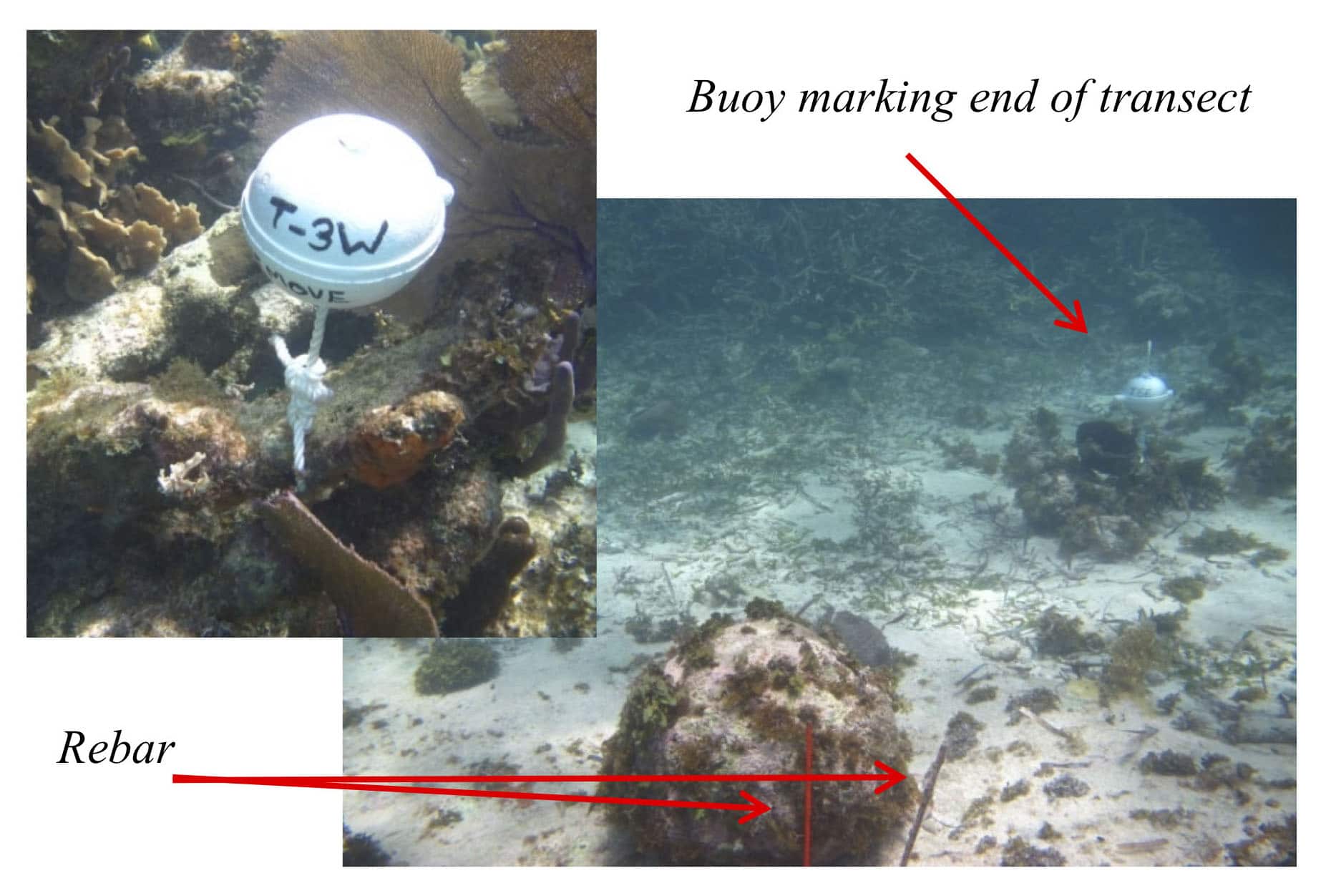
Figure 2: Each reef transect location is marked by rebar stakes, buoys, and GPS coordinates at both ends.
Prior Data from Coral Gardens
Quantitative high-resolution data on percent live coral tissue have been collected from 2012-2018 from Coral Gardens. Coral Gardens was also the subject of a 2014-2015 Advanced Keck Project. Data from prior field studies at Coral Gardens suggested that A. cervicornis populations (as well as A. palmata and the hybrid species A. prolifera) were anomalously healthy and robust at Coral Gardens, Belize. All three acroporid species (A. cervicornis, A. palmata, and A. prolifera) were present, live acroporid tissue abundance was high in many places, actively growing branch tips were common, and new coral recruits could be seen colonizing recently dead coral rubble and framework. However, 2016 saw a significant change in live coral tissue, following high 2016 El Nino temperatures and Hurricane Earl (Normile, 2016). Live coral has declined at every transect site since 2012, but the rate and timing of decline has varied across these sites. There is some hope that corals have ‘stabilized’ at 2 of the 5 locations, and the 2019 data may prove critical to assessing whether this reef can ‘bounce back’ after the challenging conditions of 2016.
Our work to date at Coral Gardens has shown that this location contains some of the largest and most extensive Acropora sp. coral populations yet documented in the Caribbean (Greer et al., 2015; Busch et al., 2016). While we have high-resolution longitudinal data from the 5 established transects at Coral Gardens, reconnaissance data from the 2014-2015 Keck Advanced project revealed many additional areas of Acropora sp. coverage in the wider area around Coral Gardens. The study by Busch et al. (2016) attempted to map these areas using satellite imagery. Initial field verification shows remarkable accuracy of this remote sensing tool. At a time when we are seeing declining live coral cover at our original sites it may now be critical to locate and establish monitoring efforts at additional locations of abundant living coral.
Radiocarbon and high resolution uranium-series data show living Acropora cervicornis coral existed at this site from at least 1915 to 2015 (Waggoner et al., 2015; Greer et al., 2016; and Waggoner, 2016 unpublished thesis). While our last Keck Project focused on determining whether Coral Gardens was a true refugia (in the ecological sense and in geologic time), this study collaboratively aims to determine whether Coral Gardens might remain a refugia, assess the geological impacts of declining coral at this site, and to locate the most promising sites of refuge within a larger geographic area.
Potential Student Projects
We envision a wealth of possible student research projects at this location. Potential student projects include the following:
Project 1: Is live A. cervicornis increasing or decreasing at Coral Gardens and is this reef in a phase transition from coral to algae dominance like most other reefs in the Caribbean? All students will participate in this project to some degree, as they will all contribute in some way to the photographic data analysis. A few students could easily make this the focus of their research experience, and several complimentary, but individual projects could evolve. We will conduct a comparative quantitative analysis of live coral tissue, macroalgae, and bare rock abundance from 2014-2019 to determine whether the coral or algae are increasing or in decline within and between sites at Coral Gardens, but also to what degree coral abundance is heterogeneous across the transect sites (which is clearly the case). 2-3 students.
Project 2: How successful was the Busch et al. (2016) remote sensing method for mapping coral populations, and can we identify and establish new habitat mapping areas in the greater Coral Gardens region? As living coral declines at our original sites it may become imperative that we find additional refugia sites to monitor moving forward. Reconnaissance of potential new acroporid sites based on satellite imagery will also provide the opportunity to better assess the novel Busch et al. (2016) mapping technique. New transects will be established at these sites. 2-3 students.
Project 3: How persistent has acroporid growth been at Coral Gardens through the well-documented period of coral decline and in recent geologic time? We already have data that indicate persistence of coral growth at Coral Gardens. But we have many samples that have not yet been dated. One project could focus on trying to obtain dates from stratigraphic sections with poor age constraint (e.g. 1925-1945 or the 1970’s). Another could focus on preparing modern samples (already in hand) to contribute to a refinement of the radiocarbon calibration curve for the Caribbean (Druffel, 1981; Reimer et al., 2013). This project would involve sample assessment for geochemical analysis (using the SEM and XRD), sample preparation for dating and analysis of geochemical data. 1-2 students.
Project 4: What is the relationship between living coral and overall carbonate budget for Coral Gardens and how heterogeneous is it across time and space? We can determine roughly how much carbonate accretion is taking place at Coral Gardens reef by estimating live coral abundance, and using published data on coral growth rates and skeletal density of coral samples for each transect site and the whole Coral Gardens reef. We can roughly estimate how fast carbonate is being excavated from reef framework by quantifying net annual bioerosion by grazers (fish and urchins) (Griffin et al., 2003 Mumby et al., 2006; Brown-Saracino et al., 2007); and macroborers from the literature (Hubbard et al., 1990; Perry et al., 2013) and the 2014-2015 Keck Advanced project to compare 2019 data with data from past years. We will place our estimates in the context of previous estimates of reef accretion from the literature. A key question centers on the degree to which the decline in live coral that we are observing will impact the geologic system as a whole. This project can easily involve several students with collaborative focus on fish, urchin, and damselfish surveys, net carbonate calculation, and the living coral dataset. 3-4 students.
Project 5: Do environmental measurements show a marked increase in temperature, conductivity, and/or light at this site from 2012-2019, and to what degree are these changes synchronous off the coast of Ambergris Caye? We have been collecting temperature data at 15 minute intervals across Coral Gardens, on land, and at additional sites (Manatee Channel to the south, and Rocky Point to the north) since 2012. We also have variable conductivity and light data from several sites. These sites span the length of Ambergris Caye, variable shallow depths, and variable exposure to open-marine water. A key question we originally asked of this project (in 2011) was what is contributing to the survival of the Coral Gardens refugia? To date we have not done a systematic analysis of the environmental data to see whether temperature at this site may have contributed to success (via exposure to flushing of ‘new’ and possibly cooler water from outside the reef), and whether temperatures are now exceeding the recent norm at this site. 1 student.
Project 6: Do stable isotope measurements from corals living over the last 100 years show a changing environment? We have Acropora cervicornis samples dating from at least 1915-2015. Very few of these samples have been analyzed for stable isotopic composition. Following a framework used by Greer et al. (2009) to investigate temperature changes crossing the mid-Holocene Thermal Maximum, we could pair radiocarbon dates with stable isotope composition to see if there are any discernable trends in temperature at this site (assuming salinity has roughly remained the same) over the last 100 years. If we could detect change on that scale, it might be the first to do so using this species of coral. 1-2 students.

Figure 3: Image A shows placement of a quadrat along an established transect and B shows the original photograph. C shows a rectified and scaled image (using MATLAB) and D shows the manual tracing of live coral cover. E shows the same image used to quantify live coral using MATLAB and F shows a map of living coral branch tips.
PROJECT LOGISTICS
Students will complete an online SCUBA knowledge course prior to the start of the project period. This course develops the knowledge base needed for SCUBA certification.
Washington and Lee University: We will spend approximately 1 week in Lexington prior to departure for Belize. The focus of this week is to explore important concepts in reef science, and develop the knowledge and skills needed for field research. Students will learn about the methods we will use, explore prior data from Coral Gardens, and learn to identify the major corals and reef organisms. We will also complete the early portion of the SCUBA certification in the W&L swimming pool.
Belize: We will spend approximately 2 weeks in Belize collecting data from the field sites using both snorkel and SCUBA. In addition to conducting all aspects of the field work, students will also complete the open-water dives for SCUBA certification, and participate in field lectures by Dr. Ken Mattes (TREC Belize; Fig. 4) and snorkeling experiences in a variety of reef habitats. We hope to also take one day to visit Mayan ruins and talk about the impacts of climate change on the Mayans.
Washington and Lee University: We will spend the last two weeks of the project period at Washington and Lee. Here students will learn analytical and computational techniques and they will quantify/analyze data. They will use the X-Ray Diffractometer (Fig. 5), Scanning Electron Microscope, High-Resolution Micromill, and Stable Isotope Mass Spectrometer. Students will process photographic data using a number of software programs including MATLAB and analyze large environmental datasets using excel. In the last week we will work with students to craft posters and abstracts, for presentation at a Fall national Geosciences meeting (GSA in Phoenix or AGU in San Francisco).

Figure 4: Accommodations at the TREC Belize research station.
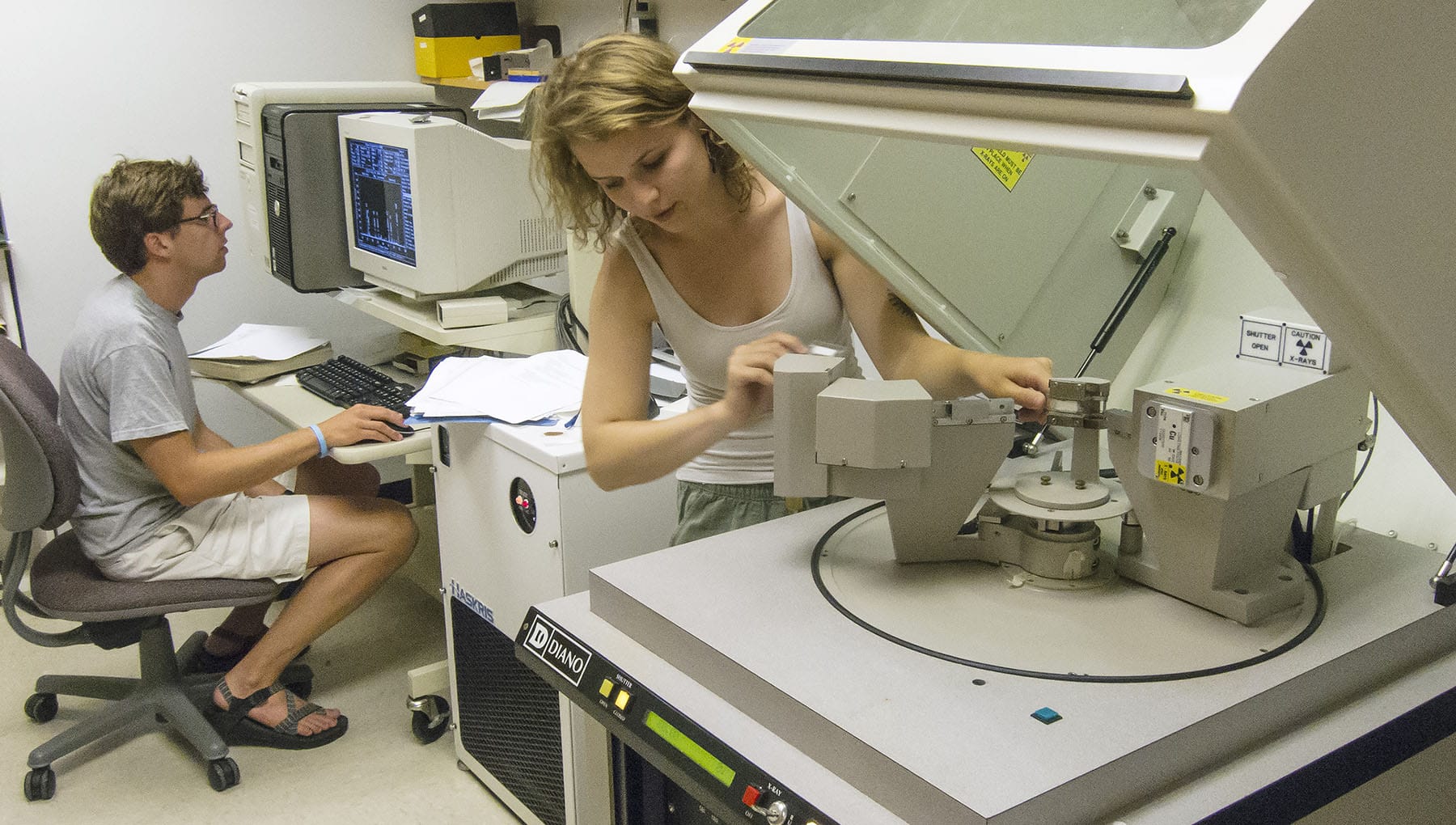
Figure 5: Keck Geology students using the x-ray diffractometer to study Belize samples.
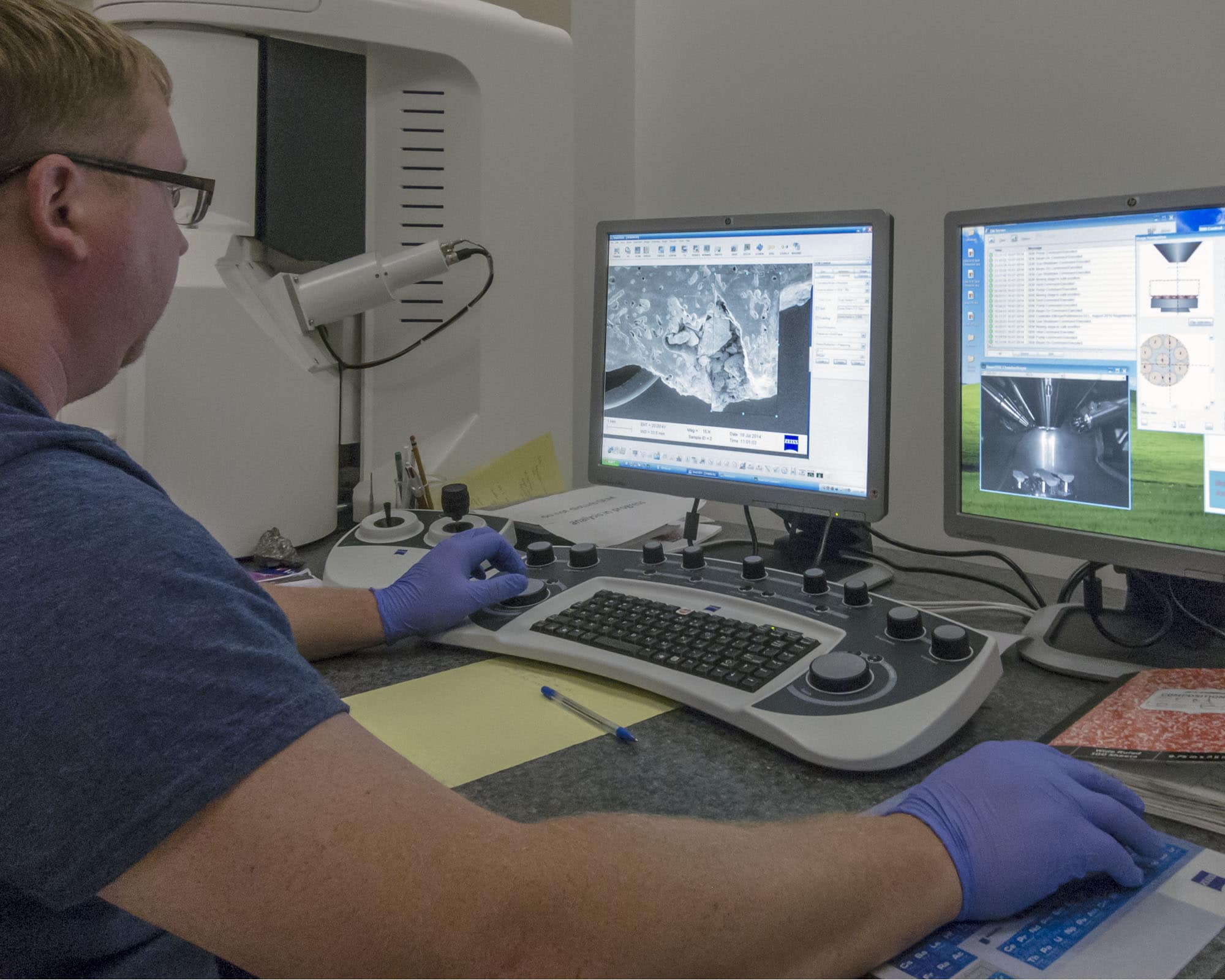
Figure 6: Keck Geology student studying Belize samples using a scanning electron microscope (SEM).
PROFESSIONAL DEVELOPMENT
Conducting a research project at an early career stage is not only a résumé-builder, but helps to develop knowledge and skills that are important to many educational, career, and life goals. Working and living together in a supportive yet challenging environment, completing a collaborative project from start to finish, and starting to develop a network of friends and colleagues all build identity as a scientist, resiliency, capabilities, and cognitive abilities. Students will work on authentic scientific questions and be trained to use state-of-the art equipment and methods. Project participants will also learn to communicate the results of their scientific investigations in both informal (e.g., general public) and formal (e.g., other professionals in the discipline.
References
Aronson, R.B., Macintyre, I.G., Precht, W.F., Murdoch, T.J.T., and Wapnick, C. M., 2002, The expanding scale of species turnover events on coral reefs in Belize. Ecological Monographs 72:233–249.
Aronson, R.B. and Precht, W.F., 2001, White-band disease and the changing face of Caribbean coral reefs. Hydrobiologia, 460:25-38.
Aronson, R.B., Precht, W.F., and Macintyre, I.G., 1998, Extrinsic control of species replacement on a Holocene reef in Belize: the role of coral disease. Coral Reefs, 17:223- 230.
Brown-Saracino, J., Peckol, P., Curran, H.A., Robbart, M.L., 2007, Spatial variation in sea urchins, fish predators, and bioerosion rates on coral reefs of Belize. Coral Reefs 26 (1):71-78.
Busch, J., Greer, L., Harbor, D., Wirth, K., Lescinsky, H., and Curran, H.A., 2016, Quantifying exceptionally large populations of Acropora spp. corals in Belize using sub-meter satellite imagery classification. Bulletin of Marine Science, v.92, pp. 265-283. http://dx.doi.org/10.5343/bms.2015.1038
Druffel EM (1981) Radiocarbon in annual coral rings from the eastern tropical pacific ocean. Geophysical Research Letters, 8(1), 59-62. doi: 10.1029/GL008i001p00059.
Greer, L., Jackson, J., Curran, H.A., Guilderson, T., and Teneva, L., 2009, How vulnerable is Acropora cervicornis to environmental change? Lessons from the early to mid-Holocene. Geology, 37:263-266.
Greer L, Lescinsky H, Wirth K., 2015, Multi-level characterization of acroporid coral populations at Coral Gardens, Belize: A refugia identified. Proceedings of the 28th Annual Keck Research Symposium in Geology. Schenectady, New York, April 2015.
Greer, L, Waggoner, T, Guilderson, T, Clark, T, Curran, HA, Busch, J, Lescinsky, H, Wirth, K, Harbor, D, 2016, Coral Gardens Belize: An Acropora spp. refugia identified. 13th International Coral Reef Symposium, Honolulu, Hawaii.
Griffin, S.P., Garcia, R.P., and Weil, E., 2003, Bioerosion in coral reef communities in southwest Puerto Rico by the sea urchin Echinometra viridis. Marine Biology, 143: 79084.
Hubbard, D.K., Miller, A.I., and Scaturo, D., 1990, Production and cycling of calcium carbonate in a shelf-edge reef system (St. Croix, U.S. Virgin Islands); applications to the nature of reef systems in the fossil record. Journal of Sedimentology, 60:335-360.
Hughes, T.P., 1994, Catastrophes, phase shifts, and large-scale degradation of a Caribbean coral reef. Science, 265(5178):1547-1551.
Hughes et al., 2017, Global warming and recurrent mass bleaching of corals. Nature, 543, 373–
377, doi:10.1038/nature21707pmid:28300113.
Hughes et al., 2018, Spatial and temporal patterns of mass bleaching of corals in the Anthropocene, Science, 359:80-83. DOI: 10.1126/science.aan8048.
Mazzullo, S.J., Anderson-Underwood, K.E., Burke, C.D., and Bischoff, W.D., 1992, “Holocene coral patch reef ecology and sedimentary architecture, northern Belize, Central America.” Palaios, 7(6):591-601.
Miller, S.L., Chiappone, M., Rutten, L.M., and Swanson, D.W., 2009, Population status of Acropora corals in the Florida Keys. Proc. of the 11th Int. Coral Reef Symp., Ft. Lauderdale, FL, 775-779.
Mumby, P.J., Dahlgren, C.P., Harborne, A.R., Kappel, C.V., Micheli, F., Brumbaugh, D.R., Holmes, K.E., Mendes, J.M., Broad, K., Sanchirico, J.N., Buch, K., Box, S., Stoffle, R.W., and Gill, A.B., 2006, Fishing, trophic cascades, and the process of grazing on coral reefs. Science, 311 (5757):98-101. DOI: 10.1126/science.1121129
Normile, D., 2016, El Niño’s warmth devastating reefs worldwide, Science, 352:15-16, DOI:
10.1126/science.352.6281.15
Pandolfi, J.M., Jackson, J.B.C., Baron, N., Bradbury, R.H., Guzman, H.M., Hughes, T.P., Kappel, C.V., Micheli, F., Ogden, J.C., Possingham, H.P., and Sala, E., 2005, Are U.S. coral reefs on the slippery slope to slime? Science, 307:1725–1726, DOI: 10.1126/science.1104258.
Perry, C.T, Murphy, G.N., Kench, P.S., Smithers, S.G., Edinger, E.N., Steneck, R.S., and Mumby, P.J., 2013, Caribbean-wide decline in carbonate production threatens coral reef growth. Nature Communications, 4:1402, DOI: 10.1038/ncomms2409.
Precht, W.F. and Aronson, R.B., 2004, Climate flickers and range shifts of reef corals, Frontiers in Ecology and the Environment, 2:307-314.
Reimer PJ, Bard E, Bayliss A, Beck JW, Blackwell PG, Bronk-Ramsey C, Grootes PM, Guilderson TP, Haflidason H, Hajdas I, HattŽ C, Heaton TJ, Hoffmann DL, Hogg AG, Hughen KA, Kaiser KF, Kromer B, Manning SW, Niu M, Reimer RW, Richards DA, Scott EM, Southon JR, Staff RA, Turney CSM, van der Plicht J (2013) IntCal13 and Marine13 Radiocarbon Age Calibration Curves 0-50,000 Years cal BP. Radiocarbon, 55(4).
Rogers, C.S., 1985. Degradation of Caribbean and western Atlantic coral reefs and decline of associated fisheries, in Proceedings of the fifth international coral reef congress, Tahiti, C. Gabrie and M. Harmelin-Vivien, editors. Volume 6. Antenne Museum-EPHE, Moorea, French Polynesia, 491-496.
Waggoner, T., Greer, L, Guilderson, T, Clark, T, Busch, J., Biegel, J., Lustig, H., Curran, HA, Lescinsky, H, Wirth, K, 2015, Chronological persistence of Acropora cervicornis at Coral Gardens, Belize. GSA Abstracts with Programs Vol. 47, No. 7.
Waggoner, T. (’16, Honors), 2016, Chronological Persistence of Acropora cervicornis at Coral Gardens, Belize. Honors Thesis
Wapnick, C.M., Precht, W.F., and Aronson, R.B., 2004, Millennial-scale dynamics of staghorn coral in Discovery Bay, Jamaica. Ecology Letters, 7(4):354-361.

